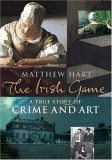The Irish Game: A True Story of Crime and Art

by Matthew Hart
ISBN: 0802714269
Post Your Opinion | | A Review of: The Irish Game: A True Story of Crime and Art
by Greg GatenbyStrangely, while I wasn't looking all that much forward to reading
Balter's book over the holiday season, I was really looking forward
to devouring The Irish Game: A True History of Crime and Art by the
UK journalist Matthew Hart. Like most of my acquaintances, I take
a head-shaking, perverse fascination in art heists and the effrontery
of the crooks so bold as to take objects which, by their nature,
belong to all of us. Certainly the 1986 theft of masterpieces worth
millions of dollars from Russborough House near Dublin in Ireland
was a news story around the planet, and it is this theft with which
Hart begins his account of how pictures are stolen, and by whom,
and for whom. Despite much evidence to the contrary, there is a
common belief that the stealing of masterworks is done at the behest
of a reclusive millionaire who keeps the contraband in some sanctum
sanctorum where he alone (for it is always a he) can salivate over
its aesthetic merits and delights. The reality is rather different,
and, while more plebian, is also more sordid, for pieces of art
have become the security deposits for major drug dealers who don't
know a Rembrandt from a Rockwell. Matthew Hart describes some of
these international machinations, but the main focus of his book
is on a gang of thugs and lowlifes from the Dublin underworld. This
is unfortunate because these thugs are not very compelling in
themselves, nor are the shenanigans of the petty world they inhabit.
I would have preferred more accounts of, and insight into, other
major art thefts, although I should note that Hart does include a
discussion of the first theft of Munch's "The Scream" in
Oslo, and ruminations on the still-unsolved theft of a Vermeer and
a Titian from the Isabella Stewart Gardner Museum in Boston. Alas,
the book's keenest weakness is the writing. Oh, the verbs follow
the nouns alright and the object follows the predicate, but the
text tries too hard for a hard-edged, tough-guy, down-these-mean
streets tone. This might have worked had Ross MacDonald or Raymond
Chandler penned the book-and were we as readers still living in the
middle of the last century. But Hart is no Chandler, and the film-noir
tenor grows irksome quickly. Still, the book is worth reaching for
because there are few competitors in the field, and, despite its
literary failings, it is informative within a small compass about
how small minds steal great art.
|